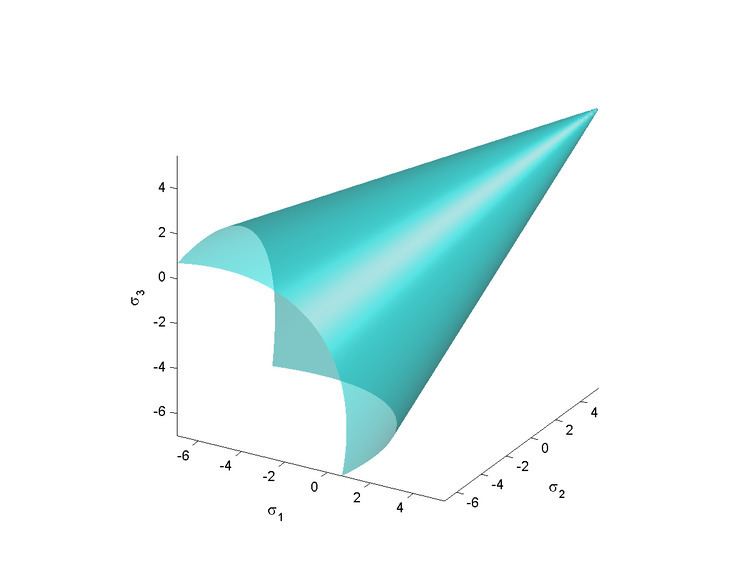 | ||
The Drucker–Prager yield criterion is a pressure-dependent model for determining whether a material has failed or undergone plastic yielding. The criterion was introduced to deal with the plastic deformation of soils. It and its many variants have been applied to rock, concrete, polymers, foams, and other pressure-dependent materials.
Contents
- Expressions for A and B
- Uniaxial asymmetry ratio
- Expressions in terms of cohesion and friction angle
- DruckerPrager model for polymers
- DruckerPrager model for foams
- Extensions of the isotropic DruckerPrager model
- DeshpandeFleck yield criterion or isotropic foam yield criterion
- Anisotropic DruckerPrager yield criterion
- The Drucker yield criterion
- Anisotropic Drucker Criterion
- CazacuBarlat yield criterion for plane stress
- References
The Drucker–Prager yield criterion has the form
where
In terms of the equivalent stress (or von Mises stress) and the hydrostatic (or mean) stress, the Drucker–Prager criterion can be expressed as
where
The Drucker–Prager yield surface is a smooth version of the Mohr–Coulomb yield surface.
Expressions for A and B
The Drucker–Prager model can be written in terms of the principal stresses as
If
If
Solving these two equations gives
Uniaxial asymmetry ratio
Different uniaxial yield stresses in tension and in compression are predicted by the Drucker–Prager model. The uniaxial asymmetry ratio for the Drucker–Prager model is
Expressions in terms of cohesion and friction angle
Since the Drucker–Prager yield surface is a smooth version of the Mohr–Coulomb yield surface, it is often expressed in terms of the cohesion (
If the Drucker–Prager yield surface middle circumscribes the Mohr–Coulomb yield surface then
If the Drucker–Prager yield surface inscribes the Mohr–Coulomb yield surface then
Drucker–Prager model for polymers
The Drucker–Prager model has been used to model polymers such as polyoxymethylene and polypropylene. For polyoxymethylene the yield stress is a linear function of the pressure. However, polypropylene shows a quadratic pressure-dependence of the yield stress.
Drucker–Prager model for foams
For foams, the GAZT model uses
where
Extensions of the isotropic Drucker–Prager model
The Drucker–Prager criterion can also be expressed in the alternative form
Deshpande–Fleck yield criterion or isotropic foam yield criterion
The Deshpande–Fleck yield criterion for foams has the form given in above equation. The parameters
where
Anisotropic Drucker–Prager yield criterion
An anisotropic form of the Drucker–Prager yield criterion is the Liu–Huang–Stout yield criterion. This yield criterion is an extension of the generalized Hill yield criterion and has the form
The coefficients
where
and
The Drucker yield criterion
The Drucker–Prager criterion should not be confused with the earlier Drucker criterion which is independent of the pressure (
where
Anisotropic Drucker Criterion
An anisotropic version of the Drucker yield criterion is the Cazacu–Barlat (CZ) yield criterion which has the form
where
Cazacu–Barlat yield criterion for plane stress
For thin sheet metals, the state of stress can be approximated as plane stress. In that case the Cazacu–Barlat yield criterion reduces to its two-dimensional version with
For thin sheets of metals and alloys, the parameters of the Cazacu–Barlat yield criterion are
